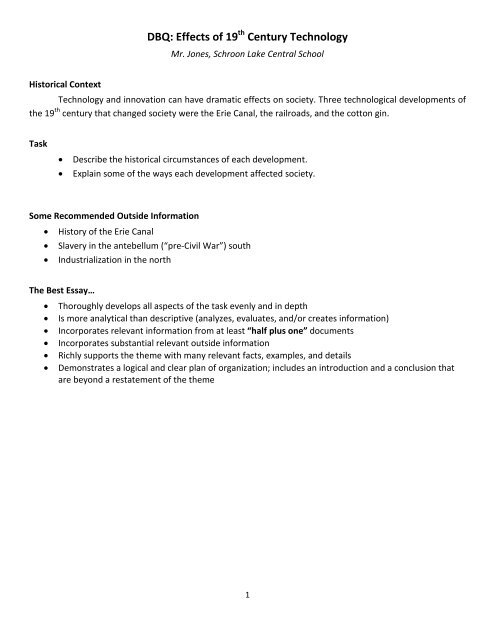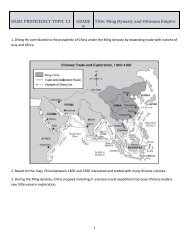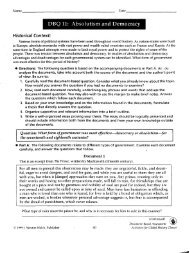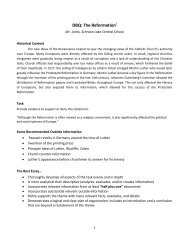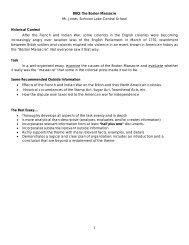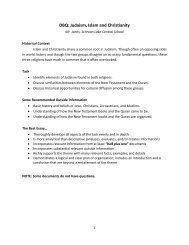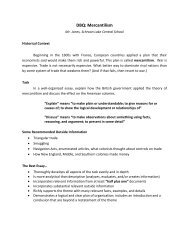DBQ Effects of 19 Century Technology
DBQ: Effects of 19th Century Technology - JonesHistory.net
DBQ: Effects of 19th Century Technology - JonesHistory.net
- No tags were found...
Create successful ePaper yourself
Turn your PDF publications into a flip-book with our unique Google optimized e-Paper software.
<strong>DBQ</strong>: <strong>Effects</strong> <strong>of</strong> <strong>19</strong> th <strong>Century</strong> <strong>Technology</strong><br />
Mr. Jones, Schroon Lake Central School<br />
Historical Context<br />
<strong>Technology</strong> and innovation can have dramatic effects on society. Three technological developments <strong>of</strong><br />
the <strong>19</strong> th century that changed society were the Erie Canal, the railroads, and the cotton gin.<br />
Task<br />
• Describe the historical circumstances <strong>of</strong> each development.<br />
• Explain some <strong>of</strong> the ways each development affected society.<br />
Some Recommended Outside Information<br />
• History <strong>of</strong> the Erie Canal<br />
• Slavery in the antebellum (“pre-Civil War”) south<br />
• Industrialization in the north<br />
The Best Essay…<br />
• Thoroughly develops all aspects <strong>of</strong> the task evenly and in depth<br />
• Is more analytical than descriptive (analyzes, evaluates, and/or creates information)<br />
• Incorporates relevant information from at least “half plus one” documents<br />
• Incorporates substantial relevant outside information<br />
• Richly supports the theme with many relevant facts, examples, and details<br />
• Demonstrates a logical and clear plan <strong>of</strong> organization; includes an introduction and a conclusion that<br />
are beyond a restatement <strong>of</strong> the theme<br />
1
Part A<br />
Short-Answer Questions<br />
Directions: Analyze the documents and answer the short-answer questions that follow each document in the<br />
space provided.<br />
Document 1A<br />
By 1825, the Erie Canal gave another boost to New York’s already busy seaports.<br />
Commercial vessels could now travel north up the Hudson River all the way to Lake Erie.<br />
This new waterway not only connected the Atlantic Ocean to the Great Lakes, it caused a<br />
terrific boon [increase] in industry all along the Hudson River and made New York’s ports<br />
and harbor more valuable than ever.<br />
Between 1830 and 1860, New York City grew at an astounding rate. ...<br />
Source: Virginia Schomp, New York Celebrates the States, Benchmark<br />
Document 1B<br />
Prior to construction <strong>of</strong> the canal, New York City was the nation’s fifth largest seaport,<br />
behind Boston, Baltimore, Philadelphia and New Orleans. Within 15 years <strong>of</strong> its opening<br />
[Erie Canal], New York [City] was the busiest port in America, moving tonnages greater<br />
than Boston, Baltimore and New Orleans combined. . . .<br />
Source: New York State Canal Corporation<br />
1a Based on the documents, state one way the Erie Canal affected the economic growth <strong>of</strong> New York State. [1]<br />
Score<br />
b Based on the documents, state one way the Erie Canal affected the economic growth <strong>of</strong> New York City. [1]<br />
Score<br />
Inter.-Level Social Studies — June ’03 [4]
Document 2<br />
Shipping Freight During<br />
the Erie Canal Era<br />
(New York City to Buffalo)<br />
Method<br />
Amount <strong>of</strong><br />
Time<br />
Cost<br />
Dirt Road<br />
Wagon<br />
21 Days<br />
$100/ton<br />
Canal<br />
Boat<br />
8 Days<br />
$10/ton<br />
Source: James Silver, American History Activities,<br />
The Center for Applied Research in Education (adapted)<br />
2a According to this chart, how many days did it take to ship freight from New York City to Buffalo using the<br />
Erie Canal? [1]<br />
Score<br />
b Using information from the chart, state two economic advantages <strong>of</strong> using the Erie Canal instead <strong>of</strong> dirt<br />
roads to transport freight during the canal era. [2]<br />
(1)<br />
(2)<br />
Score<br />
Score<br />
Inter.-Level Social Studies — June ’03 [5] [OVER]
Document 3<br />
3 Based on the map, state one way the Erie Canal was important to the economic growth <strong>of</strong> the United<br />
States. [1]<br />
Score<br />
Inter.-Level Social Studies — June ’03 [6]
Document 5<br />
Population <strong>of</strong> Western Cities<br />
City 1860 1890<br />
Denver 2,603 106,713<br />
Omaha 1,883 140,452<br />
Portland 2,874 46,385<br />
San Francisco 56,802 298,997<br />
Source: Population Abstract <strong>of</strong> the United States<br />
(from Creating America, McDougal Littell)<br />
5 What does this chart show about the effect <strong>of</strong> the transcontinental railroad on the population <strong>of</strong> western<br />
cities? [1]<br />
Score<br />
Inter.-Level Social Studies — June ’03 [8]
Document 6<br />
From the West, the railroads carried eastward such raw materials as lumber, minerals,<br />
livestock, and grain. In midwestern cities like St. Louis, Chicago, Minneapolis, and<br />
Cleveland, the raw materials were processed. Grain was milled into flour. Hogs became<br />
bacon and hams. Cattle became beef. Iron ore was converted into steel. Lumber was cut<br />
into wood for housing. The processed goods were shipped by rail to eastern cities. From<br />
eastern cities, in turn, came manufactured goods, which were sold to westerners. . . .<br />
Source: Lorna Mason et al., America’s Past and Promise, McDougal Littell<br />
6 Based on this passage, state two ways the railroads influenced economic growth in the United States. [2]<br />
(1)<br />
(2)<br />
Score<br />
Inter.-Level Social Studies — June ’03 [9] [OVER]
Part A<br />
Short-Answer Questions<br />
Directions: Analyze the documents and answer the short-answer questions that follow each document in<br />
the space provided.<br />
Document 1<br />
Eli Whitney invented the mechanical cotton gin in 1793. Before this invention, removing seeds from<br />
cotton was very time consuming.<br />
Original Model <strong>of</strong> Eli Whitney<br />
Cotton Gin, c. Early 1800s<br />
Seed cotton<br />
Diagram <strong>of</strong> How a<br />
Cotton Gin Works<br />
Cotton Gin<br />
Metal mesh<br />
Lint<br />
Saw<br />
Trash<br />
Source: Smithsonian Institution<br />
Seed<br />
Lint cotton<br />
Source: “Cotton: The Fiber <strong>of</strong> Life,”<br />
Botany: Global Issues Map, McGraw Hill (adapted)<br />
1 Based on this document, how did the use <strong>of</strong> this technology change the way cotton was processed?<br />
[1]<br />
____________________________________________________________________________________<br />
____________________________________________________________________________________<br />
Score<br />
Inter.-Level Social Studies — June ’09 [4]
Document 2<br />
Cotton Production in America, 1800–1860<br />
<br />
<br />
<br />
<br />
<br />
<br />
<br />
<br />
<br />
Source: Joyce Appleby et al., The American Journey, Glencoe/McGraw-Hill, <strong>19</strong>98 (adapted)<br />
2a Based on this document, state one effect the cotton gin had on cotton production. [1]<br />
____________________________________________________________________________________<br />
____________________________________________________________________________________<br />
Score<br />
b Based on this document, state one effect the cotton gin had on the growth <strong>of</strong> slavery. [1]<br />
____________________________________________________________________________________<br />
____________________________________________________________________________________<br />
Score<br />
Inter.-Level Social Studies — June ’09 [5] [OVER]
Document 3a<br />
. . . However, like many inventors, Whitney (who died in 1825) could not have foreseen<br />
the ways in which his invention would change society for the worse. The most significant<br />
<strong>of</strong> these was the growth <strong>of</strong> slavery. While it was true that the cotton gin reduced the labor<br />
<strong>of</strong> removing seeds, it did not reduce the need for slaves to grow and pick the cotton. In<br />
fact, the opposite occurred. Cotton growing became so pr<strong>of</strong>itable for the planters that it<br />
greatly increased their demand for both land and slave labor. In 1790 there were six slave<br />
states; in 1860 there were 15. From 1790 until Congress banned the importation <strong>of</strong> slaves<br />
from Africa in 1808, Southerners imported 80,000 Africans. By 1860 approximately one in<br />
three Southerners was a slave. . . .<br />
Source: The Eli Whitney Museum<br />
3a Based on this document, state one effect the invention <strong>of</strong> the cotton gin had on the number <strong>of</strong> slave<br />
states. [1]<br />
____________________________________________________________________________________<br />
____________________________________________________________________________________<br />
Score<br />
Document 3b<br />
. . . Because <strong>of</strong> the cotton gin, slaves now labored on ever-larger plantations where work<br />
was more regimented [organized] and relentless [unending]. As large plantations spread<br />
into the Southwest, the price <strong>of</strong> slaves and land inhibited [slowed] the growth <strong>of</strong> cities and<br />
industries. In the 1850s seven-eighths <strong>of</strong> all immigrants settled in the North, where they<br />
found 72% <strong>of</strong> the nation’s manufacturing capacity. The growth <strong>of</strong> the “peculiar institution”<br />
[slavery] was affecting many aspects <strong>of</strong> Southern life.<br />
Source: The Eli Whitney Museum<br />
3b Based on this document, state one effect the invention <strong>of</strong> the cotton gin had on the growth <strong>of</strong> cities and<br />
industries in the South. [1]<br />
____________________________________________________________________________________<br />
____________________________________________________________________________________<br />
Score<br />
Inter.-Level Social Studies — June ’09 [6]
Document 4<br />
Transportation Methods <strong>of</strong> the mid-1800s<br />
Method <strong>of</strong><br />
Transportation<br />
Roads<br />
Average<br />
Speed<br />
2 miles per hour<br />
by wagon<br />
6–8 miles per hour<br />
by stagecoach<br />
Shipping<br />
Costs<br />
15 cents per ton per mile<br />
Canals<br />
2–5 miles per hour 1.1 cents per ton per mile<br />
Railroads<br />
10–20 miles per hour<br />
(including stops)<br />
3.4 cents per ton per mile<br />
Source: George Rogers Taylor, The Transportation Revolution, 1815 to 1860,<br />
Rinehart and Company, <strong>19</strong>51 (adapted)<br />
4 Based on this chart, what was one advantage <strong>of</strong> using railroads compared with other methods <strong>of</strong><br />
transportation in the mid-1800s? [1]<br />
____________________________________________________________________________________<br />
____________________________________________________________________________________<br />
Score<br />
Inter.-Level Social Studies — June ’09 [7] [OVER]
Document 5<br />
Wanton [Merciless] Destruction <strong>of</strong> the Buffalo<br />
<br />
Source: William Edward Webb, Buffalo Land, Hubbard Brothers, 1872 (adapted)<br />
5 Based on this document, what was one negative effect <strong>of</strong> the railroad? [1]<br />
____________________________________________________________________________________<br />
____________________________________________________________________________________<br />
Score<br />
Inter.-Level Social Studies — June ’09 [8]


